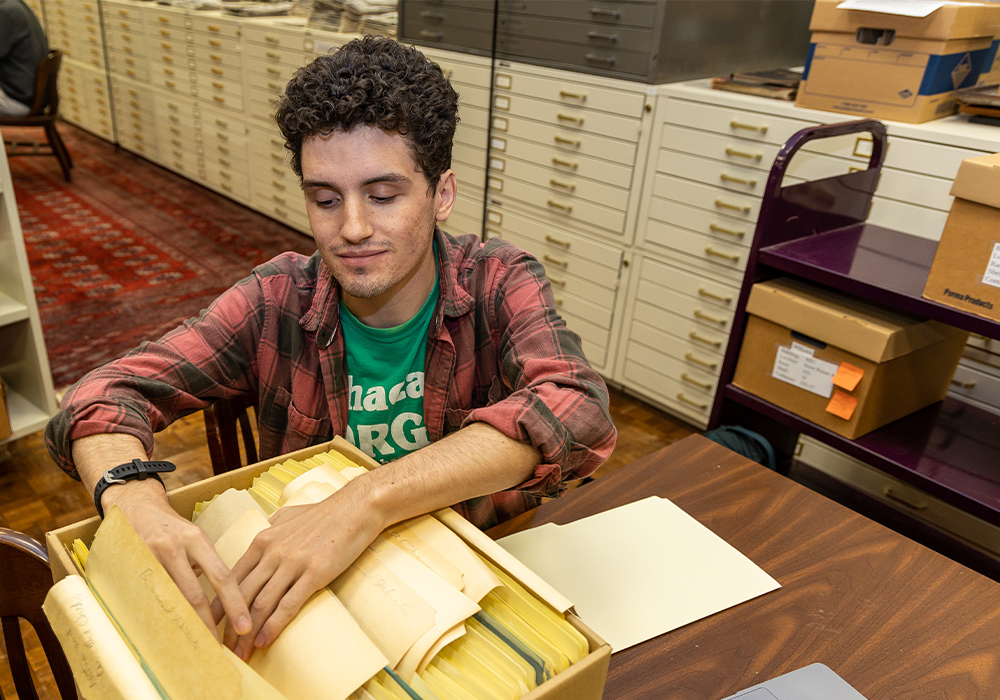Public history student Stevie Malenowski spent his summer job surrounded by boxes of documents that had not seen the light of day in decades.
Years of furniture pamphlets, corporate memos and yellowing photos tell the story of Williams Furniture Company, a major employer in Sumter, South Carolina, from the 1920s through 2004. Malenowski’s task was to sort through the collection and scan some 1,200 items for digital preservation.
He was excited to learn from the specialists at University Libraries, who taught him standards for digitization and how to create a finding guide. He was less excited, though, to learn more about lumber.
“Honestly, the last thing I wanted to do was read more about wood products,” says Malenowski. “But the great thing about history is that the more you look into things, you see these characters start to emerge.”
Malenowski came to the project after taking a graduate class with history professor Jessica Elfenbein, who has been working to create a more complete historic record of forestry in South Carolina. In researching the industry in Sumter, known as part of the “wood basket of the world,” Elfenbein learned about the Williams Furniture Company archives at Sumter County Museum.
The museum loaned the archives to USC for digitization, and the collection is now available online through the South Carolina Digital Library.
“It’s amazing to think that all this history has been largely unknown until now,” Elfenbein says. “You’d never know that the ‘Williams’ in Williams-Brice Stadium is named for this furniture company in Sumter, or how the community there rallied to bring the factory to town. It was truly a community effort, and these are stories that are very important but little-known.”
Malenowski has also gone all-in on researching Williams and stayed on into the fall semester to complete the digitization project. He’s using the archives for his graduate thesis, which examines the impact of unionization on the culture of the Williams Furniture Company and the surrounding community.
“There’s so much to unpack in just this one area,” he says. “Having a union shop with an integrated workplace at this time was practically unheard of in the South, and it’s incredible how the union played a role in changing the social fabric of the town.”
Elfenbein hopes making the archives available will bring greater awareness of the far-reaching impact of this industry for the history of Sumter, South Carolina and beyond.
Taking the archives on the road
Last fall, Elfenbein taught an undergraduate honors course to feature the Williams collection. Lynn Robertson, longtime director of USC’s McKissick Museum, co-taught the course and led the class in creating a traveling exhibit that will debut later this year.
“All the students are from different academic backgrounds — business, science, the arts and, of course, a few history majors,” Robertson says. “What’s so great is that they all bring their own backgrounds, so they all look at it from different points of view.”
The course showed students just how relevant history can be as the students worked together to bring this untold history to the public for the first time.
In addition to creating exhibition displays, they worked in teams to conduct the first seven oral histories, which provide context for the archive materials and a different angle on the company’s story.
“Initially, I thought this class was completely unrelated to me, but I was wrong,” says Lauren Reasoner, an honors student in the College of Information and Communication. “Not only am I getting to professionally design the exhibit, but I also learned how to conduct oral histories, which turned out to be a crucial part of my senior thesis.”
Reasoner interviewed a Sumter resident whose grandfather sustained a devastating injury while working in Williams’ lumber yard, which shed new light on the company’s worker safety records. Other students talked with descendants of past owners and managers of Williams.
These interviews are now transcribed and housed in the Department of Oral History in University Libraries. Malenowski, along with another student, will continue the interviews this spring, thanks to grants from the College of Arts and Sciences Humanities Collaborative and USC’s Center for Integrative and Experiential Learning.
While the Williams collection is extensive, he says it offers an incomplete view of the company’s story without the perspectives of those who worked on the factory floor.
“The Williams collection is insightful, but it’s got such obvious blind spots. The workers are practically invisible, and you’d think the managers were the ones out there chopping down trees and building cabinets,” Malenowski says. “But we’ve finally gotten a list of people who want to share their stories.”
View the Williams collection online, or learn more about the Sumter County Museum. The exhibit will travel to locations throughout the state later this year. A comprehensive website, including content from the traveling exhibit, will launch in April.
